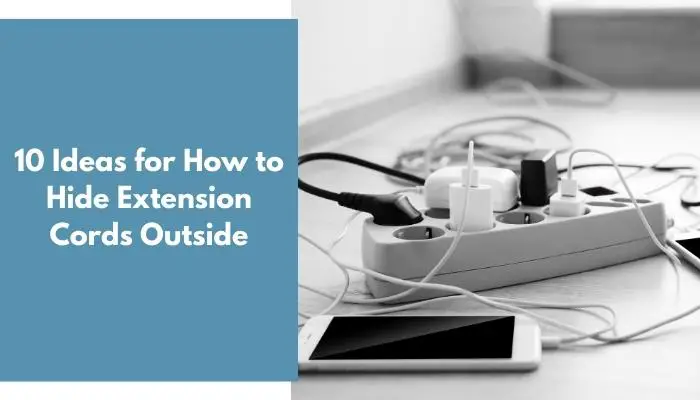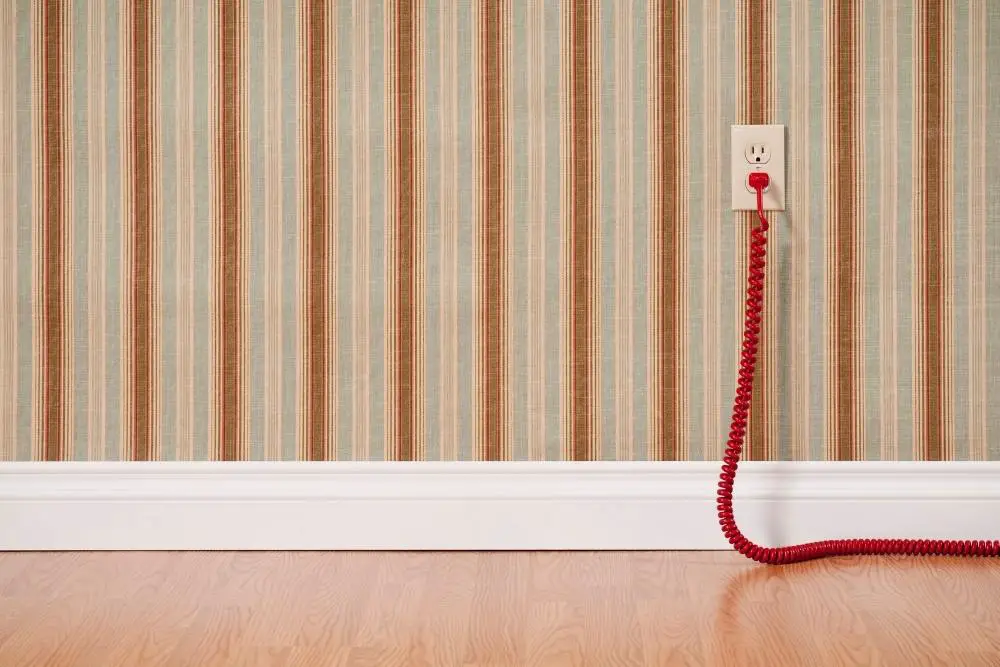Extension cords are helpful, but nobody wants them tangled in the backyard. You can trip over them when you’re not extra careful.
You can hide your extension cords using a particular barrier, such as a pool noodle or electrical tape. However, you should also ensure that the cable doesn’t produce excessive heat when activated.
This post will elaborate on some ideas on hiding extension cords outside your home.
Contents
Why Hide Outside Extension Cords?
There are numerous reasons why homeowners might want to hide their electrical cords. You can use them to improve their appearance, prevent them from getting damaged, and meet safety concerns.
No Cord Tangles
One of the safest routes to keep your extension cords free of tangles is to cover them in plastic. It will deter them from getting tangled in the wire, which can cause light to go out and lengthen the cord.
Besides being outdoors, extension cords can get tangled in various other things, such as animals and wind.
Moisture Protection
Even though electrical cords are designed for use outside, they can still be prone to damage if used for a long time.
Weather can cause the cover of an extension cord to prematurely age, which can damage the plug, cause a fire, and even cause the line to be damaged. Not only will this lead to the collapse of your cable, but it can also cause other electrical hazards.
While it’s essential to protect your extension cords from the elements, it can also be dangerous for animals to find and target them.
No Tripping Accidents
Most people have tripped over an extension cord at some point. These cords hide in almost any space, but you can also find them outside, making themselves tripping hazards.
If you can’t see a tripping hazard, you probably won’t be able to avoid it. A straightforward way to eliminate this issue is by hiding the electrical cords outside. It can make them flat and prevent them from getting tripped up.
10 Ideas for How To Hide Extension Cords Outside
There are a variety of ways to hide extension cords outside. Whether you’re looking to keep your space looking its best or clutter-free, these ideas will help you accomplish both.
Conduit
Prices pulled from the Amazon Product Advertising API on:
Product prices and availability are accurate as of the date/time indicated and are subject to change. Any price and availability information displayed on [relevant Amazon Site(s), as applicable] at the time of purchase will apply to the purchase of this product.
A conduit is a type of tube that allows you to extend an electrical cord to the other side. These are flexible and can run along garden borders, fences, and other decorative elements. They’re also ideal for connecting your electrical cords to the right place.
Although conduits can be very expensive, they are also an excellent investment for people planning on staying in the exact location for a long time.
Cord Cover
Prices pulled from the Amazon Product Advertising API on:
Product prices and availability are accurate as of the date/time indicated and are subject to change. Any price and availability information displayed on [relevant Amazon Site(s), as applicable] at the time of purchase will apply to the purchase of this product.
You can usually find cord covers made from durable materials at your local hardware store. These are typically flat and designed to protect an extension cord while also looking like your home’s siding.
These are plastic, and you can use them to add some natural beauty to your yard. They also conceal an electrical cable underneath, making them an ideal addition to your home. You can avail of them in a variety of lengths and colors.
Some cord covers also come with a plug or an access port similar to an indoor outlet. However, since these are not standard, you should always ask the shop.
Cord Boxes
While cord boxes aren’t for protecting your home’s electrical equipment, they can be a great way to keep multiple cords organized. A cord box is a good idea if you have a lot of electrical equipment in your backyard. It can help keep the wires in good working condition.
Although a cord box isn’t usually needed for every extension cord, having one handy once you deal with multiple devices can be helpful.
Plastic Bag
You can utilize a plastic bag as a temporary cover for your cables until you can get a more permanent solution. To protect your wires, use electrical tape or large garbage bags. Also, ensure that the bag packs well, so it doesn’t allow water to seep into the cable.
Electrical Tape
Prices pulled from the Amazon Product Advertising API on:
Product prices and availability are accurate as of the date/time indicated and are subject to change. Any price and availability information displayed on [relevant Amazon Site(s), as applicable] at the time of purchase will apply to the purchase of this product.
Electrical tape is better if you don’t want to use other covers. It provides better protection against animals and the elements and is easier to replace. Also, it’s more repairable than a cord.
This product only works with electrical tape. Also, remember that other adhesives, such as duct tape, will degrade faster outside than electrical tape.
Conceal Along the Walls
You can run the cord through the siding or walls if you only need power close to your home. It is similar to how other wiring works.
You can use construction staplers, eyehooks, or tape to attach electrical cords. You can use these materials to match the color of your house.
Pool Noodle
Pool noodles are an excellent tool for keeping your yard decorations looking their best, and you can also use them to protect your electrical wires. With a bit of paint and mod podge, you can make these pool noodles into a more natural-looking item.
The pool noodle can be tied, taped, or pinned in various places to keep it from getting tripped up. These are much easier to avoid than a power cable.
Grass
It is the least effective option. Although grass can provide some protection, you should tie it down to prevent it from getting tripped.
Not only does grass not protect itself against various types of damage, such as water damage and sun exposure, but it can also leave your cord vulnerable.
If you have no other options, you can still use the new grass in your yard to run your electrical cords. However, make sure that this method is temporary. We also recommend not leaving the extension cord outside for long.
Tupperware
Air-tight and watertight is an excellent way to use your extension cord. To make this work, cut a hole about as big as your extension cord.
Using a knife, slice a small slit down and put the cord in the container. When ready to use the container, open the lid and flip it over. You can then plug the cables together.
Underground Installation
You can easily hide your extension cord outside by installing it underground. This method is usually used for a long time to provide additional power to your home.
An extension cord made of PVC can extend its lifespan by using a tube made of this material. A plug or outlet cover is also required to have a weatherproof connection. Since you’ll need to install the cord into the ground, you can also use a trenching tool.
Frequently Asked Questions
How Do You Waterproof Outdoor Extension Cords?
There are various ways to waterproof your extension cords. Some of these are very expensive, and you will need to purchase multiple tools such as a plug cover, a waterproof gasket, and a conduit.
You can make a waterproof extension cord cover using various materials such as plastic bottles, containers, and cling wraps.
You can also make your cords waterproof by wrapping them in cling wrap. You can additionally plug them into plastic bottles or buckets to prevent them from getting wet.
How to Keep Your Outdoor Extension Cords Dry?
Plastic cord casings are great for keeping your outdoor extension cords dry. You can also wrap them in a bag to keep them dry or make a casing out of a bottle. To dry your cables, wrap them in electrical or duct tape.
Conclusion
Using various materials, such as electrical tape or a pool noodle, you can easily hide your extension cords. However, ensure the line doesn’t get too hot when activated.
Before using an extension cord, it’s essential to ensure it doesn’t touch the water. It is because electricity and water don’t like each other.
When using an extension cord outside, it can get wet. It’s essential to ensure that the plug and any damaged sections are dry. Doing so will prevent the cable from getting burned, sparking, or even causing an electrical shock.









